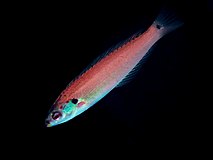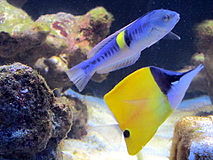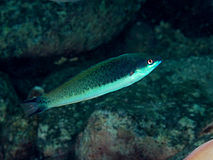Skinny boy
| Skinny boy | ||||||||||||
|---|---|---|---|---|---|---|---|---|---|---|---|---|

Pseudocoris ocellata , initial phase |
||||||||||||
| Systematics | ||||||||||||
|
||||||||||||
| Scientific name | ||||||||||||
| Pseudocoris | ||||||||||||
| Bleeker , 1862 |
The Schlankjunker ( Pseudocoris = false Coris ) are a wrasse genus that occurs in the tropical Indo-Pacific from the east coast of Africa to the Line Islands in the Central Pacific and the Tuamotu Archipelago in the South Pacific. The genus is absent in the Red Sea , Hawaii and the eastern Pacific. The German-language name Schlankjunker refers to their slim appearance and their speed. In English they are called torpedo wrasses .
features
Slender youngsters have a slender, spindle-shaped body covered with small cycloid scales and slightly flattened on the sides. They become 11 to 20 cm long. The head, as well as the bases of the dorsal and anal fin are scaly. The mouth is short and small, the eyes, seen from the side, sit in the middle of the head. The lips are thin. In the front of both jaws there is a single pair of protruding, slightly bent back fangs and slightly bent to the side. The lower pair sits between the upper ones with their mouths closed. The sides of the jaw are each covered with a row of conical teeth, the largest of which are about half as long as the fangs. Molar-shaped teeth, as in Coris , are missing. On the pharyngealia , most of the teeth are conical, a few on the edges are sharper. The sideline is continuous and runs down below the rear dorsal fin section. The spine rays of the dorsal fin are flexible, the first two are closer together than the others. In males of eight of the nine species, the first spine ray of the dorsal fin is elongated, the second can also be longer than the other fin rays. The pelvic fins are very short. The color of the fish changes greatly during growth and sex change . The caudal fin is cut off straight or rounded.
- Fin formula : Dorsal IX / 12, anal III / 12–13, pectoral 12–15, ventral I / 5, caudal 1/12/1.
- Scale formula : SL 64–81.
- Gill rake 15–23.
- Branchiostegal rays 5.
- Vertebrae: 9 + 16.
The fish likely all feed on zooplankton . So far, however, this has only been reliably proven for P. aurantiofasciata , P. heteroptera and P. yamashiroi by gastric examinations. The examined stomachs contained among others Appendikularien , sea urchin larvae , conch , Kielfüßer , foraminifera , copepods , amphipods and other, unidentifiable remains of Krebstierechen.
Systematics
P. bleekeri , secondary male, below a yellow masked tweezer fish
The genus Pseudocoris was introduced in 1862 by the Dutch ichthyologist Pieter Bleeker . It is closely related to the genus Coris , which feeds on bottom-dwelling, hard-shelled invertebrates, and probably arose from a Coris offshoot that moved on to feed on free-swimming zooplankton.
species
There are a total of nine species, three pairs of sister species, one in the Indian and the other in the Pacific Ocean, and three species endemic to different regions of the Pacific :
- Pseudocoris aequalis Randall & Walsh, 2008
- Schwarzer Schlankjunker ( Pseudocoris aurantiofasciata Fourmanoir, 1971 )
- Bleekers Schlankjunker ( Pseudocoris bleekeri (Hubrecht, 1876) )
- Pseudocoris hemichrysos Randall, Connell & Victor, 2015
- Schatten-Schlankjunker ( Pseudocoris heteroptera (Bleeker, 1857) ) ( type species )
- Pseudocoris occidentalis Randall, Connell & Victor, 2015
- Pseudocoris ocellata Chen & Shao, 1995
- Pseudocoris petila Allen & Erdmann, 2012
- Yamashiro's slim junker ( Pseudocoris yamashiroi (Schmidt, 1931) )
literature
- Dieter Eichler, Robert F. Myers: Korallenfische Zentraler Indopazifik , Jahr-Verlag GmbH & Co., 1997, ISBN 3-86132-225-0
- Ewald Lieske, Robert F. Myers: Coral fish of the world . 1994, year publisher, ISBN 3-86132-112-2
- Randall, JE, Connell, AD & Victor, BC (2015): Review of the labrid fishes of the Indo-Pacific Genus Pseudocoris , with a description of two new species . Journal of the Ocean Science Foundation, 16: 1-55.
Web links
- Pseudocoris on Fishbase.org (English)




